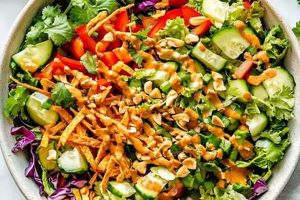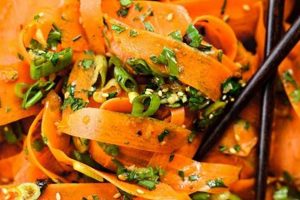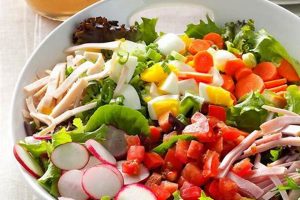A culinary creation featuring vegetables cooked through dry heat in an oven or similar appliance, then combined to form a salad. This preparation method enhances the vegetables’ natural sweetness through caramelization and adds a pleasing textural complexity. Examples include salads featuring roasted root vegetables like sweet potatoes and carrots, cruciferous vegetables like broccoli and Brussels sprouts, or alliums like onions and garlic. These roasted elements are often tossed with leafy greens, grains, cheeses, nuts, or seeds and finished with a vinaigrette.
This method of salad preparation offers several advantages. It transforms the flavors and textures of otherwise ordinary vegetables, making them more appealing and palatable. The process also increases the digestibility of certain vegetables, making their nutrients more readily available. While salads have existed for centuries, the widespread adoption of roasting vegetables specifically for salads is a more recent culinary trend, reflecting a growing appreciation for both flavor and nutritional value.
This discussion will further explore various facets of this dish, including optimal roasting techniques, ingredient pairings, and the creation of balanced, flavorful dressings.
Tips for Crafting Exceptional Roasted Vegetable Salads
Achieving optimal flavor and texture requires attention to detail throughout the preparation process. The following guidelines offer insights into creating superior roasted vegetable salads.
Tip 1: Uniform Vegetable Size: Cutting vegetables into consistent sizes ensures even cooking. Larger pieces will require longer roasting times, while smaller pieces cook more quickly. Uneven cooking can lead to some vegetables being undercooked while others are overcooked.
Tip 2: High-Heat Roasting: Employing high temperatures (400-450F/200-230C) promotes caramelization and desirable browning, enhancing both flavor and visual appeal.
Tip 3: Proper Oil and Seasoning: Adequate coating with oil ensures even cooking and helps to develop crispy exteriors. Seasoning with salt, pepper, and other herbs or spices should occur before roasting to maximize flavor penetration.
Tip 4: Avoid Overcrowding: Vegetables should be arranged in a single layer on the baking sheet to allow for proper air circulation and prevent steaming. Overcrowding inhibits browning and can result in a less desirable texture.
Tip 5: Don’t Neglect the Dressing: The dressing complements the roasted vegetables, adding acidity, brightness, and another layer of flavor. Consider a vinaigrette with a balance of oil, acid, and seasonings.
Tip 6: Introduce Textural Variety: Combining roasted vegetables with contrasting textures, such as crunchy nuts, creamy cheeses, or chewy grains, elevates the salad’s overall appeal and provides a more satisfying culinary experience.
Tip 7: Consider Seasonal Vegetables: Utilizing seasonal produce guarantees peak flavor and optimal freshness, resulting in a more vibrant and flavorful salad.
By following these guidelines, one can consistently produce flavorful, visually appealing, and nutritionally balanced roasted vegetable salads. Attention to these details elevates the dish from simple to exceptional.
These tips provide a foundation for culinary exploration and customization, encouraging experimentation with various vegetable combinations, seasonings, and dressings.
1. Vegetable Selection
Vegetable selection forms the foundation of a successful roasted vegetable salad. The choice of vegetables directly impacts the final dish’s flavor profile, texture, and nutritional value. Thoughtful consideration of vegetable characteristics and their interplay during roasting is crucial.
- Flavor Compatibility:
Certain vegetables pair well together based on their complementary flavor profiles. For instance, the sweetness of roasted carrots and parsnips harmonizes with the earthiness of beets. Conversely, strongly flavored vegetables like Brussels sprouts might overpower more delicate ones like zucchini. Understanding these relationships is essential for creating a balanced and flavorful salad.
- Texture Variation:
Selecting a variety of vegetables with different textures contributes to a more interesting and satisfying salad. Combining denser vegetables like potatoes or sweet potatoes with lighter, quicker-cooking options such as asparagus or bell peppers creates a dynamic textural experience. This interplay prevents the salad from becoming monotonous.
- Seasonal Availability:
Prioritizing seasonal vegetables ensures optimal flavor and freshness. Utilizing produce at its peak ripeness results in a more vibrant and flavorful salad. Seasonal selections also offer opportunities for variety throughout the year, reflecting the natural progression of flavors from spring greens to hearty winter roots.
- Roasting Suitability:
Not all vegetables roast equally well. Some, like root vegetables and cruciferous vegetables, thrive in high-heat environments, developing deep flavors and desirable textures. Others, such as leafy greens or delicate vegetables like tomatoes, require shorter roasting times or alternative cooking methods to prevent burning or excessive wilting. Careful consideration of each vegetable’s roasting characteristics is essential for achieving optimal results.
Strategic vegetable selection is paramount for creating a well-balanced and flavorful roasted vegetable salad. Considering factors such as flavor compatibility, textural variety, seasonal availability, and roasting suitability allows for a more nuanced and satisfying culinary experience. By understanding these principles, one can elevate the roasted vegetable salad from a simple side dish to a complex and flavorful centerpiece.
2. Roasting Technique
Roasting technique significantly influences the final quality of a roasted vegetable salad. Proper application of heat transforms raw vegetables into tender, flavorful components, enhancing their natural sweetness and creating desirable textural complexity. Understanding the nuances of roasting unlocks the full potential of this cooking method, elevating the salad from simple to exceptional.
- Temperature Control
High heat (400-450F/200-230C) is generally recommended for roasting vegetables. This temperature range promotes caramelization, creating a rich, deep flavor and desirable browning. Lower temperatures may result in steaming rather than roasting, yielding a less flavorful and potentially mushy outcome. Monitoring oven temperature and adjusting accordingly ensures consistent results.
- Cooking Time
Roasting times vary depending on the type and size of vegetables. Denser vegetables, such as root vegetables, require longer cooking times than more delicate vegetables like asparagus. Overcooking leads to dryness and loss of flavor, while undercooking results in undesirable texture. Regularly checking for doneness, using a fork to test for tenderness, is essential.
- Oil and Seasoning
Coating vegetables with oil facilitates even cooking and promotes browning. The type of oil influences the final flavor; olive oil offers a robust flavor, while avocado oil provides a neutral base. Seasoning with salt, pepper, herbs, and spices enhances the vegetables’ natural flavors. Adding seasonings before roasting allows for deeper flavor penetration.
- Spacing and Arrangement
Arranging vegetables in a single layer on the baking sheet ensures even cooking and prevents steaming. Overcrowding inhibits proper browning and can result in unevenly cooked vegetables. Using multiple baking sheets or roasting in batches guarantees optimal results.
Mastery of these roasting techniques is essential for creating a successful roasted vegetable salad. Careful attention to temperature, timing, seasoning, and spacing ensures that the vegetables reach their full flavor potential, contributing to a more complex and satisfying culinary experience. These techniques form the foundation upon which a diverse array of roasted vegetable salads can be built, allowing for creativity and customization based on individual preferences and seasonal availability.
3. Flavor Balancing
Flavor balancing is paramount in a roasted vegetable salad recipe. Roasting intensifies the natural sweetness of vegetables through caramelization. This inherent sweetness necessitates the incorporation of contrasting flavors to prevent the salad from becoming cloying. Acidity, bitterness, saltiness, and umami can all play crucial roles in achieving balance. For instance, the sweetness of roasted butternut squash can be offset by the tang of a balsamic vinaigrette, the bitterness of radicchio, the saltiness of feta cheese, or the umami of toasted walnuts. The interplay of these contrasting elements creates a more complex and satisfying flavor profile.
Achieving balance requires careful consideration of the inherent flavors of the chosen vegetables and the complementary components of the salad. Root vegetables, like carrots and sweet potatoes, tend to be sweeter after roasting, while cruciferous vegetables, such as broccoli and Brussels sprouts, can develop slightly bitter notes. Understanding these nuances allows for strategic pairings. A salad featuring roasted sweet potatoes might benefit from the addition of a bright citrus vinaigrette and toasted pecans to provide acidity and a contrasting textural element. Conversely, a salad with roasted Brussels sprouts could be balanced with the addition of dried cranberries and a Dijon mustard vinaigrette to introduce sweetness and tang.
Failure to balance flavors adequately can result in a one-dimensional salad that lacks complexity and depth. A salad dominated by sweetness might become monotonous, while an overly bitter or acidic salad can be unappetizing. Strategic flavor balancing elevates the roasted vegetable salad from a simple combination of ingredients to a carefully crafted culinary experience, showcasing the interplay of contrasting tastes and textures. This understanding allows for greater control over the final product and encourages experimentation with different flavor combinations, resulting in more dynamic and satisfying salads.
4. Texture Contrast
Texture contrast plays a vital role in the overall enjoyment of a roasted vegetable salad. The roasting process itself creates a foundational textural element: the tender interior and slightly crisp exterior of the vegetables. However, relying solely on this can result in a monotonous sensory experience. Introducing contrasting textures elevates the salad, making it more engaging and satisfying. This can be achieved through the incorporation of various ingredients, each contributing a unique textural dimension.
Crunchy elements provide a counterpoint to the softness of roasted vegetables. Nuts, such as toasted almonds or pecans, offer a satisfying bite. Seeds, like sunflower or pumpkin seeds, contribute a delicate crunch. Croutons, either homemade or store-bought, add a crisp, bread-like texture. Raw vegetables, like thinly sliced red onion or shredded carrots, introduce a refreshing crispness. These contrasting textures prevent the salad from becoming overly soft or uniform.
Creamy or smooth textures offer another layer of contrast. Soft cheeses, like goat cheese or feta, provide a creamy counterpoint to the roasted vegetables. Avocado adds a rich, buttery smoothness. A dollop of hummus or a sprinkle of toasted coconut flakes introduces different nuances of creaminess. These elements balance the firmer textures of the roasted vegetables and other crunchy additions. Consider a salad of roasted root vegetables with toasted walnuts, crumbled goat cheese, and a sprinkle of pomegranate seeds. The interplay of soft roasted vegetables, crunchy nuts, creamy cheese, and the juicy pop of pomegranate seeds creates a multi-dimensional textural experience.
Understanding the importance of texture contrast allows for the creation of more dynamic and satisfying roasted vegetable salads. The strategic incorporation of crunchy and creamy elements elevates the dish beyond simply roasted vegetables, transforming it into a more complex and enjoyable culinary experience. This awareness empowers culinary experimentation and customization, leading to a greater appreciation for the role of texture in creating balanced and flavorful dishes.
5. Dressing Choice
Dressing choice is an integral component of a successful roasted vegetable salad recipe. The dressing serves not merely as a condiment but as a unifying element, harmonizing the flavors of the roasted vegetables and any additional components. A well-chosen dressing enhances the existing flavors, adds complexity, and provides balance. An inappropriate dressing, conversely, can overwhelm the delicate flavors achieved through roasting or clash with other ingredients. Careful consideration of dressing characteristicsacidity, sweetness, texture, and flavor profileis essential for creating a cohesive and flavorful salad.
- Acidity
Acidity provides a necessary counterpoint to the sweetness often intensified in roasted vegetables. Vinegar-based dressings, whether a classic vinaigrette, balsamic glaze, or a citrus-infused dressing, cut through the richness of the vegetables and brighten the overall flavor profile. The level of acidity should be balanced; too much can make the salad overly tart, while too little can leave it feeling heavy and unbalanced. A lemon vinaigrette, for example, provides a bright counterpoint to the earthy sweetness of roasted root vegetables.
- Flavor Profile
The dressing’s flavor profile should complement the roasted vegetables and other ingredients. Herbaceous dressings, like those featuring parsley, dill, or mint, can enhance the freshness of spring vegetable salads. Nutty dressings, such as tahini-based dressings, pair well with roasted squash or eggplant. Spicy dressings, incorporating chili flakes or sriracha, can add a kick to salads featuring heartier vegetables like Brussels sprouts or broccoli. A maple- Dijon vinaigrette complements roasted Brussels sprouts and pecans.
- Texture
Dressing texture contributes to the overall sensory experience. A creamy dressing, like a ranch or blue cheese dressing, provides a textural contrast to the roasted vegetables, especially when those vegetables possess a crispy exterior. A thinner vinaigrette allows the textures of the roasted vegetables to take center stage. Thicker dressings cling better to the vegetables, ensuring that each bite is coated in flavor. The chosen texture should enhance, not detract from, the salad’s overall composition.
- Oil Choice
The oil used in the dressing contributes flavor and mouthfeel. Extra virgin olive oil lends a robust, peppery flavor, while avocado oil provides a more neutral backdrop. Nut oils, such as walnut or hazelnut oil, impart distinct flavors that can complement specific vegetable combinations. The oils flavor should harmonize with the other dressing ingredients and the roasted vegetables themselves. For example, a walnut oil vinaigrette complements roasted beets and goat cheese.
Careful consideration of these elements ensures that the dressing complements, rather than competes with, the other components of the salad. A well-chosen dressing elevates the roasted vegetable salad, transforming it from a simple assemblage of ingredients into a cohesive and flavorful dish. By understanding the interplay between dressing characteristics and roasted vegetables, one can create a harmonious culinary experience that showcases the best of both.
6. Ingredient Quality
Ingredient quality significantly impacts the final outcome of a roasted vegetable salad recipe. While technique and flavor combinations play crucial roles, the inherent quality of the ingredients forms the foundation upon which a truly exceptional salad is built. Utilizing fresh, high-quality produce and thoughtfully selecting complementary components elevates the dish from satisfactory to extraordinary. Compromising on ingredient quality, conversely, can result in a lackluster salad, regardless of culinary skill.
- Freshness of Produce
The freshness of the vegetables directly influences their flavor, texture, and nutritional value. Peak-season produce, whether sourced from a local farmers market or carefully selected from a grocery store, offers optimal flavor and texture. Vegetables that are past their prime can be bland, mushy, or even bitter, detracting from the overall quality of the salad. Freshly harvested vegetables retain more nutrients and contribute to a more vibrant and flavorful final product. For example, using recently harvested asparagus results in tender, flavorful spears, whereas older asparagus can be tough and stringy.
- Sourcing and Selection
Thoughtful sourcing and selection of ingredients extends beyond mere freshness. Considering the origin of the produce, such as opting for locally grown options whenever possible, supports sustainable agriculture and often results in superior flavor. Selecting vegetables with vibrant colors and firm textures indicates optimal quality. Damaged or bruised produce should be avoided, as these imperfections can negatively impact flavor and texture. For instance, choosing firm, brightly colored bell peppers over those that are wrinkled or soft ensures optimal flavor and texture in the finished salad.
- Complementary Components
Ingredient quality extends beyond the vegetables themselves. The other components of the salad, such as nuts, seeds, cheeses, and the dressing ingredients, should also be of high quality. Using fresh herbs, high-quality oils, and flavorful cheeses enhances the overall complexity and balance of the salad. Rancid nuts or stale cheese can detract from the final product, undermining the efforts put into roasting the vegetables. Opting for fresh, flavorful ingredients across the board elevates the salad from a simple side dish to a culinary masterpiece. Freshly grated Parmesan cheese, for example, offers a far superior flavor compared to pre-grated, packaged varieties.
- Oil and Vinegar Selection
The choice of oil and vinegar significantly impacts the dressing’s flavor and, consequently, the overall success of the salad. High-quality extra virgin olive oil possesses a robust flavor and contributes to a smooth, luxurious mouthfeel. Freshly squeezed citrus juice or a high-quality vinegar provides the necessary acidity to balance the sweetness of the roasted vegetables. Using inferior oils or vinegars can result in a bland or unbalanced dressing that detracts from the other flavors in the salad. For instance, a balsamic vinaigrette made with a high-quality balsamic vinegar offers a complex sweetness and depth of flavor that enhances the roasted vegetables.
Prioritizing ingredient quality is fundamental to creating an exceptional roasted vegetable salad. The freshness and quality of the produce, along with the careful selection of complementary components and dressing ingredients, contribute to a more flavorful, visually appealing, and ultimately more satisfying culinary experience. Investing in high-quality ingredients enhances the natural flavors achieved through roasting and elevates the salad to its full potential, demonstrating a commitment to both flavor and nutritional value. By understanding the crucial role of ingredient quality, one can consistently produce roasted vegetable salads that are not only delicious but also showcase the best of what fresh, seasonal produce has to offer.
7. Presentation
Presentation plays a significant role in the overall enjoyment of a roasted vegetable salad recipe. While flavor and texture are paramount, visual appeal enhances the dining experience, stimulating appetite and creating a sense of anticipation. Thoughtful presentation elevates the perceived value of the dish, transforming it from a simple meal into a more sophisticated culinary creation. Consideration of color, arrangement, and serving style contributes to a more appealing and satisfying sensory experience.
- Color Palette
Roasted vegetables offer a naturally vibrant color palette. The caramelization process deepens the hues of vegetables, creating rich browns, golden yellows, and deep oranges. Strategic arrangement of these roasted vegetables can create visual interest. Incorporating fresh herbs, such as vibrant green parsley or deep purple basil, adds contrasting pops of color. A sprinkle of bright red pomegranate seeds or a scattering of toasted nuts introduces further visual complexity. A visually appealing salad is more enticing and contributes to a more enjoyable dining experience. For example, a salad featuring roasted butternut squash, red onion, and broccoli offers a visually appealing combination of orange, purple, and green.
- Arrangement and Composition
The arrangement of the roasted vegetables and other components influences the overall presentation. Simply tossing all the ingredients together can result in a visually unappealing jumble. Consider arranging the roasted vegetables intentionally, creating patterns or contrasting textures. A bed of leafy greens can provide a backdrop for the roasted vegetables, showcasing their vibrant colors. Sprinkling feta cheese or toasted nuts over the salad adds visual texture and dimension. A drizzle of dressing, applied just before serving, adds a final touch of gloss and visual appeal. For instance, arranging roasted asparagus spears in a circular pattern around a mound of quinoa creates a visually appealing focal point.
- Serving Style and Vessels
The choice of serving vessel contributes to the overall presentation. A large platter allows for a dramatic presentation, showcasing the variety of roasted vegetables and other components. Individual bowls or plates offer a more personalized touch and allow for greater control over portion size and arrangement. Serving the salad on a bed of greens or grains adds another layer of visual interest and texture. The serving style should complement the overall aesthetic of the salad and the occasion. Serving a composed salad in individual ramekins, for example, creates a more elegant presentation than simply tossing all the ingredients together in a large bowl.
- Garnishes and Finishing Touches
Garnishes add a final flourish to the presentation. A sprinkle of fresh herbs, a drizzle of balsamic glaze, or a scattering of toasted nuts or seeds elevates the visual appeal and adds a touch of elegance. The garnish should complement the flavors of the salad and enhance, not overpower, the other components. A simple garnish can transform a basic roasted vegetable salad into a more visually sophisticated dish. A sprinkle of chopped chives, for example, adds a pop of color and a subtle onion flavor to a salad featuring roasted root vegetables. Similarly, a drizzle of balsamic glaze adds visual interest and a touch of sweetness.
Thoughtful presentation enhances the enjoyment of a roasted vegetable salad. By considering color palette, arrangement, serving style, and garnishes, one can elevate the perceived value and create a more enticing and satisfying dining experience. Visual appeal complements the flavors and textures achieved through roasting, resulting in a more complete and enjoyable culinary experience. These elements, combined with high-quality ingredients and proper roasting techniques, transform a simple roasted vegetable salad into a visually stunning and flavorful dish.
Frequently Asked Questions
This section addresses common inquiries regarding the preparation and enjoyment of roasted vegetable salads.
Question 1: How can one prevent roasted vegetables from becoming overly dry?
Adequate oil coating and proper roasting times are crucial. Vegetables should be tossed with enough oil to lightly coat all surfaces. Avoid overcrowding the baking sheet, which can lead to steaming. Adhering to recommended roasting times for specific vegetables prevents overcooking and dryness. Testing for doneness with a fork ensures optimal tenderness.
Question 2: What are the best oils for roasting vegetables?
Oils with higher smoke points are ideal for roasting. Olive oil, avocado oil, and grapeseed oil are suitable choices. The specific oil chosen can also complement the overall flavor profile of the salad. For example, a robust extra virgin olive oil imparts a distinct flavor, while avocado oil offers a more neutral base.
Question 3: Can frozen vegetables be used in roasted vegetable salads?
While fresh vegetables are generally preferred, frozen vegetables can be used in certain situations. Excess moisture should be removed before roasting to prevent steaming. Roasting times may need adjustments due to the initial freezing process. Certain frozen vegetables, such as peas or corn, may not achieve the same textural results as their fresh counterparts.
Question 4: How long can roasted vegetable salads be stored?
Properly stored, roasted vegetable salads can typically last for three to five days in the refrigerator. Storing the vegetables and dressing separately helps maintain optimal texture and prevents the salad from becoming soggy. The salad should be stored in an airtight container to maintain freshness and prevent absorption of odors from other foods.
Question 5: How can one adapt roasted vegetable salads for different dietary needs?
Roasted vegetable salads offer inherent versatility for dietary adaptations. Vegan options can be achieved by omitting cheese and using plant-based dressings. Gluten-free versions can be created by ensuring all ingredients, including the dressing, are gluten-free. Adjustments to oil and sodium content can address specific health concerns. Ingredient substitutions, such as using maple syrup in place of honey, cater to specific dietary restrictions.
Question 6: What are some strategies for creating balanced flavor profiles in roasted vegetable salads?
Balancing the sweetness of roasted vegetables with contrasting flavors is key. Acidity from vinegar-based dressings, bitterness from leafy greens, saltiness from cheese or olives, and umami from nuts or seeds all contribute to a more complex and satisfying flavor profile. The interplay of these elements prevents the salad from being one-dimensional.
Understanding these key aspects of preparation and storage ensures consistent success in creating flavorful and enjoyable roasted vegetable salads.
This information provides a foundation for further exploration of recipe variations and customization options.
Roasted Vegetable Salad Recipe
Exploration of this culinary concept reveals a dish offering remarkable versatility and depth. Careful consideration of vegetable selection, roasting techniques, flavor balancing, textural contrast, dressing choice, ingredient quality, and presentation elevates the final product from a simple side dish to a sophisticated culinary creation. This multifaceted approach allows for a wide range of flavor profiles and textural experiences, adaptable to diverse palates and dietary preferences. The inherent nutritional value of vegetables, enhanced by the roasting process, further contributes to this dish’s appeal.
Mastery of these elements empowers culinary creativity and encourages ongoing experimentation. The potential for customization within this framework allows for continuous refinement and the development of unique flavor combinations. Roasted vegetable salad recipes represent not a static formula but a dynamic platform for culinary expression, reflecting seasonal variations and individual preferences. This adaptability ensures its enduring relevance within the evolving culinary landscape.






